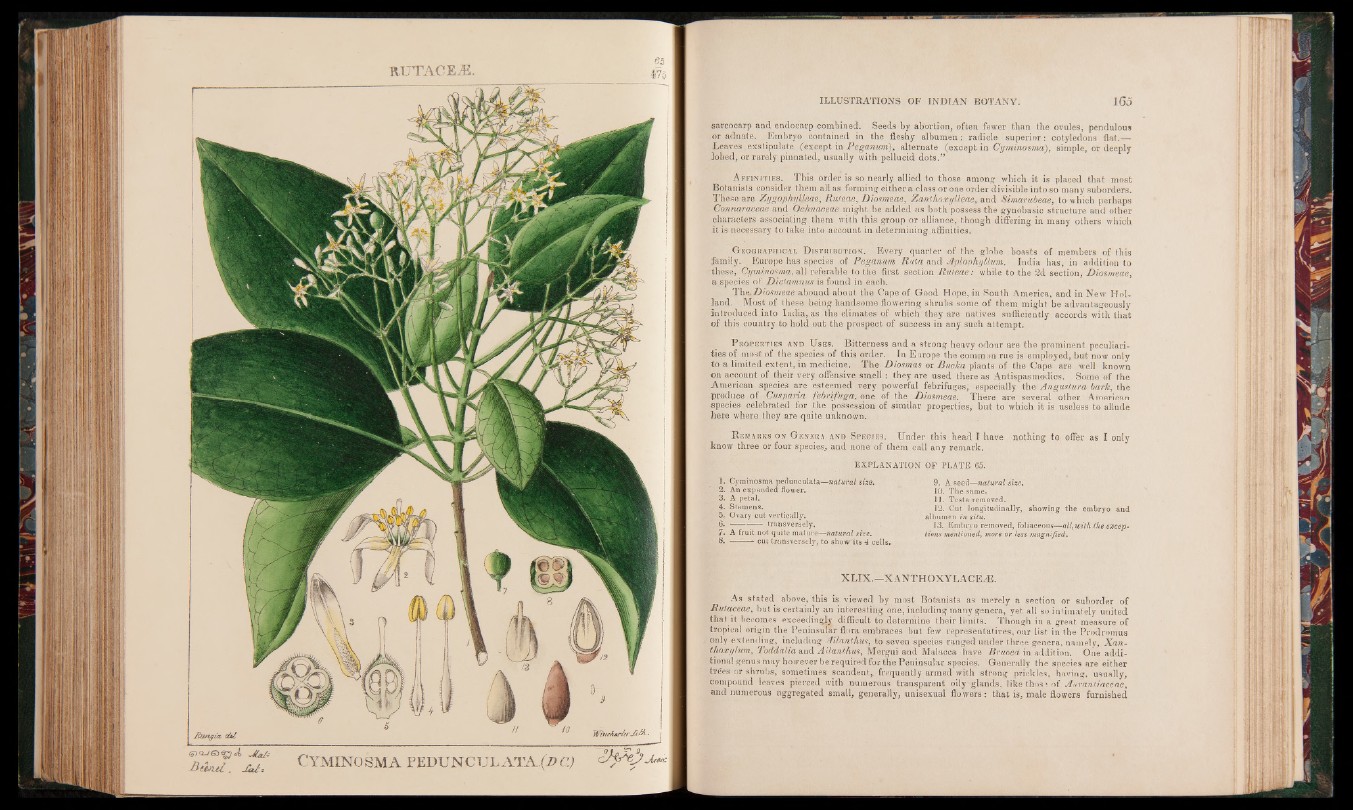
RUTACEÆ.
H w igia, cùZ WzTieAM’/cf-/t$' -
S tn JG X g A , JC a/-
J ifin e Z . Jht-. CYMINOSMA FEDUNCULATA.(i)(1)
sarcocarp and endocarp combined. Seeds by abortion, often fewer than the ovules, pendulous
or adnate. Embryo contained in the fleshy albumen : radicle superior: cotyledons flat.—
Leaves exstipulate (except in Peganum), alternate (except in Cyminosma), simple, or deeply
lobed, or rarely pinnated, usually with pellucid dots.”
Affinities. This order is so nearly allied to those among which it is placed that most
Botanists consider them all as forming either a class or one order divisible into so many suborders.
These are ZygophyUeae, Ruteae, Diosmeae, Zanthoxylleae, and Simarubeae, to which perhaps
Connaraceae and Ochnaceae might be added as both possess the gynobasic structure and other
characters associating them with this group or alliance* though differing in many others which
it is necessary to take into account in determining affinities.
Geographical Distribution. Every quarter of the globe boasts of members of this
family. Europe has species of Peganum Rata and Aplophyllum. India has, in addition to
these, Cyminosma, all referable to the first section Ruteae: while to the 2d section, Diosmeae,
a species of Diclamnus is found in each.
The,Diosmeae abound about the Cape of Good Hope, in South America, and in New Holland.
Most of these being handsome flowering shrubs some of them might be advantageously
introduced into India, as the climates of which they are natives sufficiently accords with that
of this country to hold out the prospect of success in any such attempt.
P roperties and Uses. Bitterness and a strong heavy odour are the prominent peculiarities
of most of the species of this order. In Europe the common rue is employed, but now only
to a limited extent, in medicine. The. Diosmas or Bucka plants of the Cape are well known
on account of their very offensive smell: they are used there as Antispasmodics. Some of the
American species are esteemed very powerful febrifuges, especially the Angustura bark, the
produce of Cusparia febrifuga, one of the Diosmeae. There are several other American
species celebrated for the possession of similar properties, but to which it is useless to allude
here where they are quite unknown.
R emarks on Genera and Species. Under this head I have nothing to offer as I only
know three or four species, and none of them call any remark.
EXPLANATION OF PLATE 65.
1. Cyminosma pedunculata—natural size.
2. An expanded flower.
3. A petal.
4. Stamens.
5. Ovary cut vertically.
ti. ■— -— transversely.
7. A fruit not quite mature—natural size.
8. — ^ cut transversely, to show its 4 cells.
9. A seed—natural size.
10. The same.
11. Testa removed.
12. Cut longitudinally, showing the embryo and
albumen in situ.
13. Embryo removed, foliaceous—all, with the exceptions
mentioned, more or less magnified.
XLIX.—XANTHOXYLACEA3.
As stated above, this is viewed by most Botanists as merely a section or suborder of
Rutaceae, but is certainly an interesting one, including many genera, yet, all so intimately united
that it becomes exceedingly difficult to .determine their limits. Though in a great measure of
tropical origin the Peninsular flora embraces but few representatives, our list in the Prodromus
only extending, including Ailanthus, to seven species ranged under three genera, namely, Xan-
thoxy/um, Toddalia and AUant.hus, Mergui and Malacca have Brucea in addition. One additional
genus may however be required for the Peninsular species. Generally the species are either
trees or shrubs, sometimes scandent, frequently armed with strong prickles, having, usually,
compound leaves pierced with numerous transparent oily glands, like thos5 of A /irantiaceae,
and numerous aggregated small, generally, unisexual flowers: that is, male flowers furnished